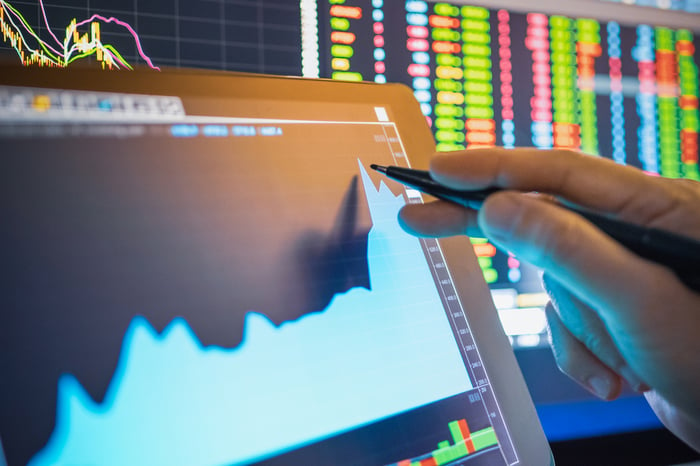Regardless of whether you've been putting your money to work on Wall Street for decades or are a relatively new investor, 2022 was a struggle. All three major U.S. stock indexes plunged into a bear market, with the growth-oriented Nasdaq Composite (^IXIC 2.19%) bringing up the caboose. The Nasdaq shed 33% of its value last year and lost as much as 38% from its November 2021 peak.
But therein lies the opportunity.

Image source: Getty Images.
Although we'll never know in advance when a bear market will begin, how long it'll last, or how steep the decline will be, we do know that every bear market throughout history has eventually been put into the back seat by a bull market rally. This effectively makes every bear market a buying opportunity for patient investors.
It can be an especially smart time to put your money to work in innovative growth stocks that've been beaten down by the bear market. Here are three remarkable growth stocks that have the potential to double your money over the next 18 months.
Nio
The first phenomenal growth stock that's fully capable of doubling your money over the next year and a half is China-based electric-vehicle (EV) manufacturer Nio (NIO 8.23%).
Like most EV manufacturers, Nio had a rough 2022. The combination of China's zero-COVID strategy disrupting auto sales and domestic supply chains, coupled with historically high inflation and increasing competition, slowed both production and Nio's push toward recurring profitability. Even though the company is liable to lose money again in 2023, the expectation is for significant operating improvement in the new year and a push toward recurring profitability in 2024.
Perhaps the biggest catalyst for Nio is China effectively ripping off the Band-Aid and ending its zero-COVID mitigation strategy. While this could lead to a painful couple of months if COVID-19 ravages the country, it'll ultimately return business activity to normal and remove many of the supply chain constraints that have reduced Nio's production for the past couple of years.
From a consumer demand standpoint, Nio is excelling. The company has been introducing at least one new EV each year, and in December the company delivered a record 15,815 EVs. Prior to COVID-19 wrecking the auto industry supply chain, management believed Nio was on pace to ramp to 50,000 EVs in monthly output in 12 months.
Nio is also standing up to industry titans and coming out the winner. For example, the ET7 and ET5 sedans introduced last year can deliver 621 miles of range with the top battery pack upgrade. This allows these EVs to go head-to-head with Tesla's flagship Model 3, which has an estimated range of approximately 315 miles.
Lastly, Nio has the dangling carrot necessary to keep early buyers loyal to the brand. In the summer of 2020, it rolled out its battery-as-a-service subscription, which allows buyers to charge, swap, and upgrade their batteries. Even though this service provides a discount on the purchase price of new Nio EVs, it generates high-margin subscription revenue for Nio and locks those buyers into the brand for (presumably) years to come.
Lovesac
The second remarkable growth stock that can produce triple-digit returns by the summer of 2024 despite the Nasdaq bear market is furniture stock Lovesac (LOVE -0.41%).
Generally speaking, the furniture industry is slow growing. Most retailers are almost entirely dependent on foot traffic into brick-and-mortar stores, and many retailers purchase products from the same small group of wholesalers. Lovesac brings three competitive advantages to the table that should allow it to excel and disrupt this industry.
As I recently pointed out, the company's furniture is the first clear-as-day differentiating factor. Though it was once known for its beanbag-styled chairs called "sacs," close to 88% of net sales today derive from "sactionals." A sactional is a modular couch that can be arranged multiple ways to fit most living spaces. In addition to top-tier function, sactionals have over 200 different cover choices, and the yarn used in their production comes from recycled plastic water bottles.
The next selling point for Lovesac is that it predominantly targets middle-to-upper-income millennials. Sactionals come with a number of potential add-ons, such as wireless charging and surround-sound systems. This makes Lovesac products pricier than most couches in traditional furniture stores.
However, Lovesac's customers are more resilient to inflation and economic disruptions. This is why the company's sales have continued to grow by a double-digit percentage, even in the face of a weaker U.S. economy.
Third, Lovesac's omnichannel sales platform is working wonders. Though the company operates 189 retail stores in 40 U.S. states, it's been able to shift a significant percentage of its sales online, as well as lean on pop-up showrooms and partnerships to boost sales. The point is that Lovesac's overhead expenses are lower than traditional furniture retailers.
If Lovesac can demonstrate that Wall Street's concern about rising inventory levels was for naught in 2023, its share price shouldn't have any trouble doubling for investors by mid-2024.

Image source: Getty Images.
Novavax
The third remarkable growth stock that can double your money in 18 months, even with the Nasdaq bear market in full effect, is biotech stock Novavax (NVAX 3.54%).
Novavax qualifies as one of the COVID-19 pandemic's biggest winners and losers. The development of the COVID-19 vaccine NVX-CoV2373 put the company on the map and sent its valuation soaring. However, Novavax endured multiple delays to its Emergency Use Authorization filing in key markets, as well as vaccine production delays.
Novavax's stock ultimately plunged as much as 97% from its pandemic high. But at this point, Wall Street's pessimism appears to be overblown.
Focusing on the company's COVID-19 vaccine yields two key advantages. To begin with, NVX-CoV2373 is a protein-based vaccine, not a messenger-RNA-based vaccine. In other words, the Novavax vaccine relies on older technology that's been around for a while to help a patient's immune system recognize and fight back against infection. This makes it an intriguing choice for vaccine holdouts.
Secondly, NVX-CoV2373 is one of only three authorized COVID-19 vaccines to have reached the elusive 90% vaccine efficacy (VE) level. Although VE is just one of many important figures in COVID-19 clinical studies, it's a key number that physicians and patients have used in deciding which vaccine to administer or take. NVX-CoV2373 should also see its use as a booster soar in 2023.
Something else to be excited about is the potential for combination vaccines involving NVX-CoV2373, as well as vaccines in other areas of focus, such as influenza and respiratory syncytial virus (RSV). We know the company's vaccine-development platforms works -- now it's just a matter of diversifying its revenue stream.
Finally, Novavax finished up September with $1.28 billion in cash and cash equivalents, which is before adding $250 million in gross proceeds from a recent share sale and convertible debt offering. It's well capitalized and perfectly positioned for a bounce-back year in 2023.





